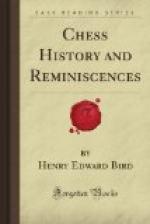We notice with great pleasure the handsome and courteous manner in which almost all the prominent chess masters of the day are mentioned in the book, and the sense of fairness evinced by Mr. Bird in the selection of variations and examples from his own practice, irrespective of his victory or defeat. But his chess historical references are unreliable, and he often wrongly ascribes the adoption of certain variations to different players in a manner which could have been easily rectified by taking a little more trouble. This is not unimportant, for the reputed strength of a player is evidence of the strength of an opening he favours in matches and tournaments. We can only adduce a few instances which are more within the writer’s personal knowledge.
The statement about 5. Q to K2, in the Buy Lopez, on page 16, is much confused. The move was adopted by Mr. Blackburne in the final tie match of the Vienna tournament, but it never occurred in the first game of the Steinitz-Blackburne match, as Mr. Bird can convince himself from his own book, where the latter game is published in full on page 171. Steinitz is also erroneously credited with strongly favouring the attack in the Scotch Gambit, for we do not remember a single game on record in which he ever adopted that form of opening as first player. On the other hand, a variation in the Evans Gambit is ascribed to Zukertort, which actually occurred first in a game between Steinitz and Blackburne, played in the London Grand Tournament of 1872. This error seems to have been quoted from Staunton and Wormald’s “Chess Theory and Practice.”
A few more words about the problems at the end of the book and we have done with the details. There are about a dozen compositions mostly by high-class American authors, and some of them of very good quality; but, unfortunately, Mr. Bird has omitted to indicate their solutions. We must suppose this to be due to an oversight, as he gives the key moves of the four problems by English composers. The omission is deplorable, for many students would wish to appreciate the author’s idea, and the merits of the construction, if they fail to solve the problem. To quote an instance from our own experience; we could not find any solution to the problem on page 224, which composition, we conclude, is either of the highest order or suffers from the gravest of all faults, that of being impossible. In either case we should have liked to examine the solution.
Our judgment of the book, on the whole, is that it cannot be ranked in the first class with the works of Heydebrand, Zukertort, Staunton, Lowenthal, Neuman and Suhle, Lange, &c.; but it will satisfy the demands of the great number of lovers of the game who do not aspire above the second rank. Mr. Bird’s ability and ingenuity is beyond doubt, and there is ample evidence of his qualifications in the book before us, but he has not yet acquired that element of genius which has been defined as the capacity for taking pains. Mr. Bird could produce a much better book than this, and we hope he will.




